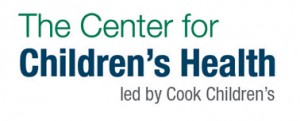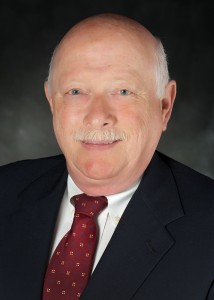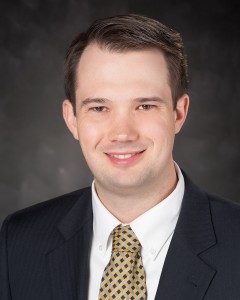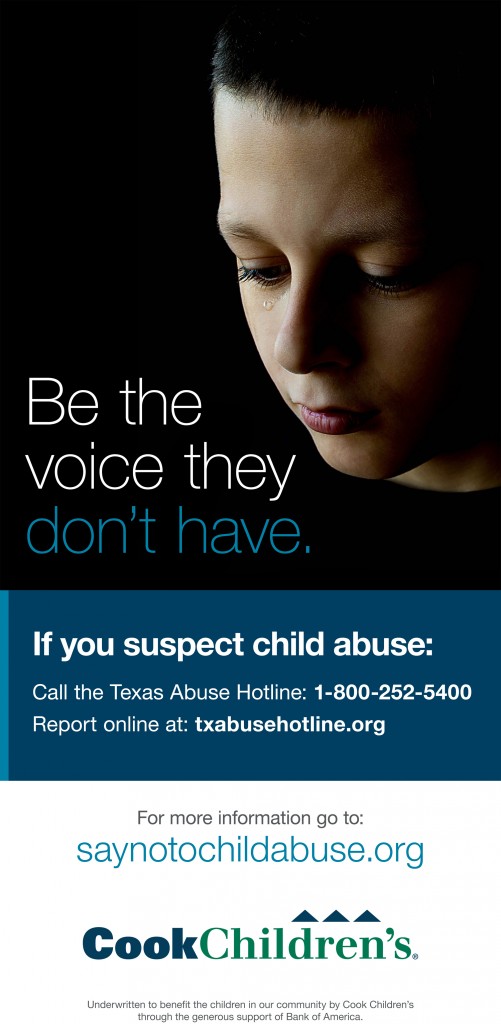How Cook Children’s Health System Fights Back Against Child Abuse
// By Lisa D. Ellis //
 The faces of two beautiful toddlers practically jump off the Star Telegram’s website, their vibrant expressions and sparkling eyes captured so clearly on the screen that it’s hard to believe that both of these youngsters are no longer living.
The faces of two beautiful toddlers practically jump off the Star Telegram’s website, their vibrant expressions and sparkling eyes captured so clearly on the screen that it’s hard to believe that both of these youngsters are no longer living.
Tragically, these children—who did not know each other but are both believed to be victims of child abuse a few years apart—each died suddenly, before ever getting to fully experience life. But at least there’s hope that their memories might serve a great purpose: to help save other children in Tarrant County, Texas, who are also at risk for experiencing child maltreatment.
Raising Community Awareness

Larry Tubb, senior vice president of The Center for Children’s Health led by Cook Children’s
These toddlers’ stories are being shared as part of an in-depth public awareness campaign, a collaborative effort between the newspaper and Cook Children’s Health System in Fort Worth, a not-for-profit system that operates a full continuum of pediatric care, including a medical center, physician network, home health company, Northeast Hospital, pediatric surgery center, health plan, health services, and health foundation. All of these services are geared to the varied needs of young residents of high-risk areas in and around Fort Worth and where child abuse is an ongoing concern in the pediatric emergency room and hospital, according to Larry Tubb, senior vice president of The Center for Children’s Health led by Cook Children’s.
In fact, Tarrant County currently holds the record for the highest number of child maltreatment cases in the state, with 10.9 victims per 1,000 children, according to a 2013 report by the Texas Department of Family and Protective Services, compared with the national average of 9.2 per 1,000 children. (Last year, this translated to 5,689 confirmed child abuse cases in Tarrant County.)
The hope is that the Star Telegram’s child abuse series, which ran in early June and consisted of three days of print coverage and digital articles, was effective in alerting people to the prevalence of child abuse. The newspaper looked at how to recognize the problem, how to try to stop the cycle, and why and how to report suspected cases. This is all crucial, since all too often, people don’t speak up about child abuse because they aren’t sure what the process is to report it or what will happen next, Tubb says.
Tubb also says that while collaboration with the newspaper to raise community awareness about child abuse is a new initiative, Cook Children’s commitment to address child maltreatment has actually grown out of a multi-step process that began more than a decade ago.
How It All Began
“In the mid-1990s, we were building an integrated delivery network just for children. We were trying to create a medical home across the continuum of care. We were successful in this effort, even while an overwhelming majority of others were not,” Tubb explains. “But when we got to the end of the process, we asked ourselves what we wanted to do with the system now that we had built it.”
After much exploration, the answer was clear. “We decided that in addition to providing expert medical care, we wanted to see if we could work in the community and be proactive to keep kids well, rather than waiting to treat them when they become ill,” he says.
As part of pursuing this goal, Cook Children’s needed to understand issues facing children in the area and to understand exactly what health meant for them.
“There was a lot of information about people ages 15 and up, but we did not know much about children ages 0 to 14. And what did exist was at the national level. There was nothing locally,” Tubb says. As a result, Cook Children’s decided to conduct its own research, which it called Community-wide Children’s Health Assessment and Planning Survey. From fall 2008 to fall 2009, it had 7,000 responses to its questionnaire, all from parents of kids ages 0 to 14.
“When we analyzed the results, we took them to the board of trustees and they rolled up their sleeves and said, out of everything we heard, ‘What are the things that if Cook Children’s were involved we could have an impact on?’” Tubb recalls.
This led the health system to identify seven factors to focus on. These included:
- Asthma
- Obesity
- Mental Health
- Safety from Accidents and Injuries
- Child Abuse
- Access to Care
- Dental Health
Forming the Center for Children’s Health
Out of this process, the health system ultimately formed the Center for Children’s Health, which officially opened in 2012 and now operates under the Cook Children’s umbrella. The center began addressing all seven of the issues it has defined, and while all of these areas remain a focus, by 2014 it had deepened its commitment to child abuse, recognizing that there was a gap and hoped to help fill it.
“We observed in our research of child abuse that nearly every provider of services to children has some program to address child abuse, but all of them put their resources to dealing with the issue, not preventing it,” Tubb says. “We decided to experiment and see if we could focus on prevention.”
Using Customer Analytics to Identify High-Risk Areas
 At about the same time, Cook Children’s Health System was working with Buxton, a Fort Worth-based firm that specializes in customer analytics to collect patient information and systematically combine it with household data to understand who uses the hospital’s services, how to market to them most effectively, and also to identify other potential customers.
At about the same time, Cook Children’s Health System was working with Buxton, a Fort Worth-based firm that specializes in customer analytics to collect patient information and systematically combine it with household data to understand who uses the hospital’s services, how to market to them most effectively, and also to identify other potential customers.

Peter Healey, vice president of account management at Buxton
Such customer analytics is a growing trend that many health care organizations are tapping into to help grow their market share, explains Peter Healey, vice president of account management at Buxton. This information can also help to identify areas where child abuse can be a greater risk.
Using household data, hospital records, and records from local Child Protective Services and other local agencies, Cook Children’s was able to identify some factors that seem to increase the risk of child maltreatment. These include:
- Domestic violence
- Runaway teens
- Sexual assault
- Criminal assault
“When these things are present, it is more likely for child abuse to occur,” Tubb says. In fact, by some estimates, the risk of child abuse is 150 percent greater than in areas where these factors are not an issue.
“We were able to use risk terrain modeling/risk assessment using geospatial analytics. That allowed us to narrow in on a three-block area where child abuse is most likely to occur,” he says. This means that Cook Children’s can take a large, overwhelming issue and narrow its impact down to a very defined and concrete space. In fact, findings revealed that a full 80 percent to 90 percent of all child abuse cases in Fort Worth occur in just 40 percent of the geographic area, Tubb says. This is very significant since it helps the center, along with other groups addressing child abuse and related risk factors, to very strategically plan where to focus prevention efforts to have the largest impact.
Further, by relying on Buxton’s expertise in psycho-demographic segmentation to begin to understand the types of households where child abuse may occur, Cook Children’s has also recognized the importance of tailoring different messages for different needs.
“If we’re trying to reach people who live in a neighborhood, we need to understand that different people have different circumstances and therefore will respond to different things. That means for three households, you may need three different messages,” Tubb says. “Understanding the different people who live in a neighborhood, determining who they are, what they care about—and what channels will reach them—is the power that Buxton brings to the relationship,” he adds.
Shedding Light on a Dark Area
The Star Telegram public awareness project is a big step on the road to communicating with the community at large and starting a dialogue about child abuse and the need to be proactive in trying to stop it. “We are trying to shed light on a dark area that no one wants to talk about,” Tubb says. He adds that the center’s next steps are to continue using the Buxton data and other insights to come up with interventions that hopefully will keep any more area children from becoming victims.
Lisa D. Ellis is the editor of Strategic Health Care Marketing. She is a journalist and content development specialist who helps hospitals and other health care providers and organizations shape strategic messages and communicate them to their target audiences. You can reach her at editor@strategicHCmarketing.com.

